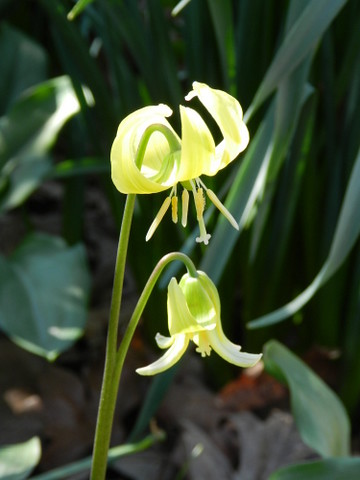
The dog tooth violets (Erythronium species) in my garden are in full bloom and boy oh boy, I love these wildflowers! Imagine a large area covered by these beautiful little yellow blooms. The cultivar I grow is 'Pagoda' and I have read where 'Pagoda' is one of the showiest dog tooth violets so I am quite happy with my purchase of about 65 bulbs two years ago from John Scheepers bulbs. These bulbs are not as expensive as many other wildflowers tend to be, so don't hesitate to purchase some. They are most rewarding and very easy to grow. I have (had) mine in a shaded area under a vernal witch hazel which is next to a mature oak tree. The bulbs did not mind the dryness or the full shade or the tree roots. I recently dug them all up and moved them to my new land. Their new location is right next to our driveway in what will definitely be a spring/wildflower/bulb garden. The area I planted them is under a Japanese maple 'Bloodgood' right next to some Stinking hellebores (Helleborus foetidus) and the dog tooth violets came through the move wonderfully.
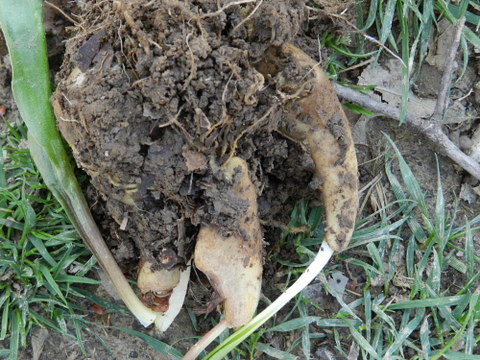
Have you ever thought about the bulbs of these little violets, that are not in the violet family at all? Why do you suppose they call them both dog tooth violets and trout lilies? The trout lily part is pretty easy. The leaves are mottled and sometimes striped and resemble a trout. They are really quite beautiful. My 'Pagoda' dog tooth violets have some mottling on the foliage but in this particular cultivar the mottling is not as pronounced as in other cultivars.
The reason these wildflowers are called 'dog tooth' is very simple and plain to me as I looked at the bulbs when I dug them up in preparation for transplanting. The bulbs and the little offsets actually do look like a dog's tooth! A large canine tooth with some smaller teeth around it. The stem grows from the tip of the canine tooth so the above bulbs are actually pictured upside down from how they grow. Isn't that pretty cool?
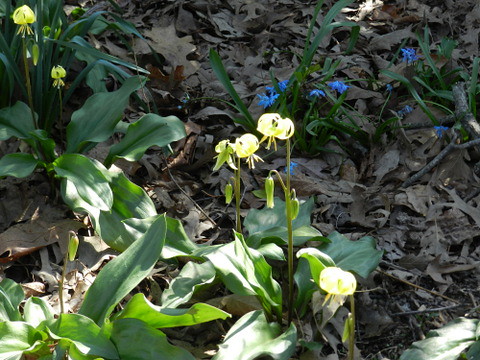
The yellow flowers look great with the blue of the scilla in the woodland garden!
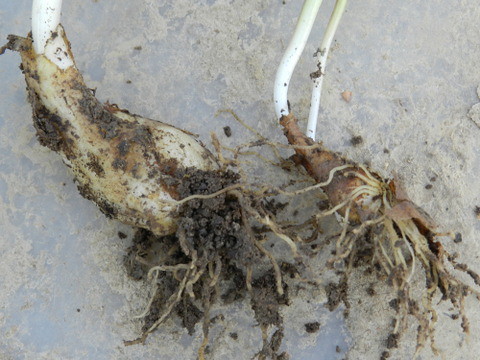
In the garden I have found that in the two years since I planted these bulbs they have been easy to care for. I was quite concerned about moving them, but I needn't have worried because when I dug the bulbs I found they were quite easy to dig. It may be that after a few more years the bulbs may grow deeper but in my case the bulbs were all within about 4-5" of the soil surface. Other than untangling them from daffodils and tree roots I had no trouble digging and separating these bulbs, tho I did try to leave them in the existing soil they were in. In many cases I did not separate any of the little bulbs.
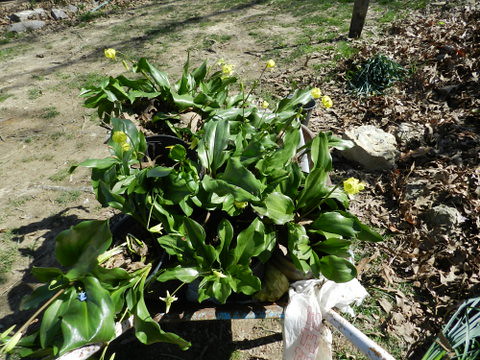
Here are most of the freshly dug bulbs in a tray and in pots in my wheelbarrow awaiting transport to the farm. These bulbs, like most bulbs, should be planted right away. I planted mine the same day I dug them and was fortunate that the very next day a rain came and watered them all into the rocky ground. These wildflowers, unlike many wildflowers, did not even wilt upon being dug. That is encouraging to this gardener! Soon I suspect all of these bulbs will go dormant and I'll forget about them until next year when they slowly emerge from the ground.
The area I planted them in is quite different from where I took them from but it is still a similar area to how the bulbs grow naturally in the wild. You see, my driveway soil is quite rocky and a bit gravelly, and is very acid in nature. The area is also mostly shaded in the summer surrounded by deciduous trees such as shagbark hickories, locusts, oaks, ash, and elms. In the winter and early spring when these bulbs are growing sunlight does come in nicely. I think once these bulbs settle in they will be fine and hopefully spread themselves around this 250 foot section of our driveway.
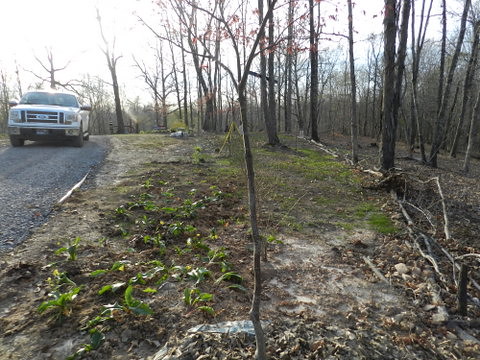
I have separated the 'cultivated' wildflower area from the wild area along the driveway by some fallen tree trunks. The fescue grass was planted as a groundcover last fall after we cleared all the trash from this area. Clearing the trash was a good thing but we unfortunately cleared a lot of organic material that will slowly replace itself over the years. It is important dog tooth violets have organic matter and a good cover of fallen leaves so I am slowly mulching the driveway area with leaves. I think the fescue grass will eventually die out as the wildflowers and leaves and nature takes over. This is a good thing as I have no intention of mowing this area in the woods due to its rocky nature. There is a row of six Japanese maples, including the one in the foreground right next to the dog tooth violets. Between the maples are some shrubs like St. John's wort, kerria, and azaleas. In front of these shrubs; which serve as a boundary; are the wildflowers and bulbs and hellebores. So far all are doing well....
in the woodland garden....
I'll be on vacation visiting sunny Florida this week so I am extending the giveaway until next Monday from this Friday. I will do the drawing Sunday evening and post the winner on Monday. Sorry for any inconvenience. If you have not already commented on my giveaway post or on Skeeter's please do so now!
It will all be beautiful when filled in. Have a great time.
ReplyDeleteI love dogtooth violets and this is such an informative post. Many thanks.
ReplyDeleteThose violets are great. Sounds like they move very well. What a great greeting along your driveway. I like the use of the logs to mark your change in planting vs. wild plants. Enjoy your time in Florida!
ReplyDeleteIn our part of the world we stick with Trout Lily.
ReplyDeleteFabulous and my natives are a bit different but still lovely
ReplyDeleteYes, I see the dogs teeth in the roots! How cool is that... I do wonder at times why a plant has a certain name and in this case, you have solved the mystery for us...
ReplyDelete